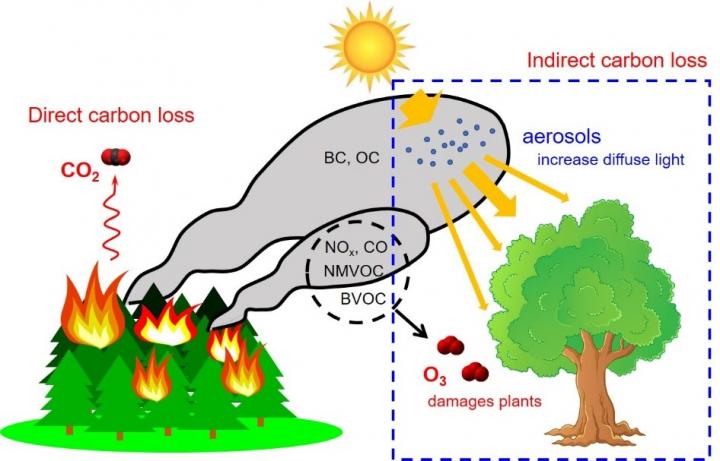Fire air pollution weakens forest productivity

Indirect carbon loss caused by fire O3 and aerosols. Credit: Xu Yue
In addition to the carbon emissions, fire plumes also generate air pollutants, including ozone (O3) and fine mode aerosols (e.g., PM2.5, particulate matter less than 2.5 μm in diameter).
It's well known that these air pollutants may worsen air quality in the local and downwind regions. However, it's not known that they also change land carbon budget by influencing photosynthesis of unburned forests.
Recently, a new study in Nature Communications explored the ecological impacts of fire air pollution. Increases in O3 and aerosols have opposite impacts on plant health.
O3 is phytotoxic and reduces plant photosynthesis, while aerosols may promote photosynthesis by enhancing diffuse radiation. It is unclear what's the net impacts of these pollutants on biosphere from the same fire.
This study combined three state-of-the-art models and a full set of observations from ground sites, satellites, and literature, to quantify the net impacts of fire O3 and aerosols on gross primary productivity (GPP), a metric representing total photosynthesis of forests.
Results show that surface O3 reduces global GPP by 4.9 Pg C (3.6%) every year, in which fire O3 accounts for ~20%. In contrast, global aerosols enhance annual GPP by 1.0 Pg C (0.8%) with fire contributions of only 5%.
The fertilization effect of fire aerosols is very limited, likely because fire emissions usually occur in tropical forests where dense cloud masks the aerosol effects. Consequently, the net impact of fire air pollution is dominated by O3, leaving a reduction of 0.9 Pg C (0.6%) in annual GPP.
Regionally, fire air pollution causes larger damages to forest productivity. For example, the 2006 large fire in Indonesia reduces local GPP by 3.6%. Furthermore, the fire pollution can cause impacts through long-range transport.
We find GPP reductions of 0.6% in eastern U.S. and 0.5% in eastern China where fire events are very limited. In those regions, high level of background O3 from human activities provides such a sensitive environment that even a mild increase in O3 by fires can cause a discernable influence.
This new research reveals a missing pathway of fire impacts on global carbon cycle. The damage to ecosystem productivity not only occurs in fire regimes, but also over the downwind areas through long-range transport of air pollution.
“Such negative impacts may exacerbate in the future as fire activities are expected to escalate in a warming climate.” said Xu Yue, the first author of the study from Institute of Atmospheric Physics, Chinese Academy of Sciences.
Media Contact
More Information:
http://dx.doi.org/10.1038/s41467-018-07921-4All latest news from the category: Earth Sciences
Earth Sciences (also referred to as Geosciences), which deals with basic issues surrounding our planet, plays a vital role in the area of energy and raw materials supply.
Earth Sciences comprises subjects such as geology, geography, geological informatics, paleontology, mineralogy, petrography, crystallography, geophysics, geodesy, glaciology, cartography, photogrammetry, meteorology and seismology, early-warning systems, earthquake research and polar research.
Newest articles

Nerve cells of blind mice retain their visual function
Nerve cells in the retina were analysed at TU Wien (Vienna) using microelectrodes. They show astonishingly stable behavior – good news for retina implants. The retina is often referred to…

State-wide center for quantum science
Karlsruhe Institute of Technology joins IQST as a new partner. The mission of IQST is to further our understanding of nature and develop innovative technologies based on quantum science by…

Newly designed nanomaterial
…shows promise as antimicrobial agent. Rice scientists develop nanocrystals that kill bacteria under visible light. Newly developed halide perovskite nanocrystals (HPNCs) show potential as antimicrobial agents that are stable, effective…



